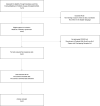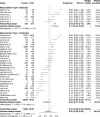This is a preprint.
Objective sensory testing methods reveal a higher prevalence of olfactory loss in COVID-19-positive patients compared to subjective methods: A systematic review and meta-analysis
- PMID: 32676608
- PMCID: PMC7359533
- DOI: 10.1101/2020.07.04.20145870
Objective sensory testing methods reveal a higher prevalence of olfactory loss in COVID-19-positive patients compared to subjective methods: A systematic review and meta-analysis
Update in
-
Objective Sensory Testing Methods Reveal a Higher Prevalence of Olfactory Loss in COVID-19-Positive Patients Compared to Subjective Methods: A Systematic Review and Meta-Analysis.Chem Senses. 2020 Dec 5;45(9):865-874. doi: 10.1093/chemse/bjaa064. Chem Senses. 2020. PMID: 33245136 Free PMC article.
Abstract
Severe acute respiratory syndrome coronavirus 2 (SARS-CoV-2), which causes coronavirus disease 2019 (COVID-19), has currently infected over 6.5 million people worldwide. In response to the pandemic, numerous studies have tried to identify causes and symptoms of the disease. Emerging evidence supports recently acquired anosmia (complete loss of smell) and hyposmia (partial loss of smell) as symptoms of COVID-19, but studies of olfactory dysfunction show a wide range of prevalence, from 5% to 98%. We undertook a search of Pubmed/Medline and Google Scholar with the keywords "COVID-19," "smell," and/or "olfaction." We included any study that quantified olfactory loss as a symptom of COVID-19. Studies were grouped and compared based on the type of method used to measure smell loss-subjective measures such as self-reported smell loss versus objective measures using rated stimuli-to determine if prevalence rate differed by method type. For each study, 95% confidence intervals (CIs) were calculated from point estimates of olfactory disturbance rates. We identified 34 articles quantifying anosmia as a symptom of COVID-19, collected from cases identified from January 16 to April 30, 2020. The pooled prevalence estimate of smell loss was 77% when assessed through objective measurements (95% CI of 61.4-89.2%) and 45% with subjective measurements (95% CI of 31.1-58.5%). Objective measures are a more sensitive method to identify smell loss as a result of infection with SARS-CoV-2; the use of subjective measures, while expedient during the early stages of the pandemic, underestimates the true prevalence of smell loss.
Keywords: COVID-19; SARS-CoV-2; anosmia; coronavirus; olfactory dysfunction.
Figures


References
-
- World Health Organization. Internet: https://www.who.int/emergencies/diseases/novel-coronavirus-2019.
-
- Center for Disease Control. Internet: https://www.cdc.gov/coronavirus/2019-ncov/symptoms-testing/symptoms.html (accessed June 5th 2020 2020).
-
- Menni C, Valdes A, Freydin MB, Ganesh S, El-Sayed Moustafa J, Visconti A, Hysi P, Bowyer RCE, Mangino M, Falchi M, et al. Loss of smell and taste in combination with other symptoms is a strong predictor of COVID-19 infection. medRxiv 2020:2020.04.05.20048421. doi: 10.1101/2020.04.05.20048421. - DOI
-
- Iravani B, Arshamian A, Ravia A, Mishor E, Snitz K, Shushan S, Roth Y, Perl O, Honigstein D, Weissgross R, et al. Relationship between odor intensity estimates and COVID-19 population prediction in a Swedish sample. medRxiv 2020:2020.05.07.20094516. doi: 10.1101/2020.05.07.20094516. - DOI - PMC - PubMed
Publication types
Grants and funding
LinkOut - more resources
Full Text Sources
Other Literature Sources
Miscellaneous
